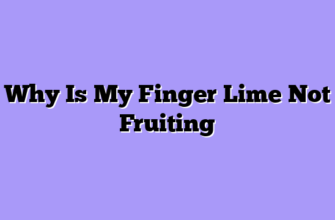I’ll never forget the day I butchered my first finger lime tree. There I was, brand new pruning shears in hand, convinced that my years of experience with apple trees would translate perfectly to these exotic beauties. Boy, was I wrong! I hacked away at that poor tree like I was trimming a hedge, removing nearly 40% of the canopy in one brutal afternoon session. The tree went into shock, dropped most of its developing fruit, and took two full seasons to recover from my overzealous “pruning.” That expensive mistake taught me the most important lesson about finger lime care: these trees don’t follow traditional citrus rules.
You see, finger limes are like that artistic friend who marches to their own drummer – they’re productive and beautiful, but only when you respect their natural tendencies. Unlike regular citrus trees that benefit from aggressive annual pruning, finger limes prefer a gentle, minimalist approach. Think of it as the difference between a military haircut and a subtle trim at an upscale salon. Both achieve a goal, but one leaves you looking sharp while the other might leave you hiding under a hat for months.
Over the past decade, I’ve developed what I call the “less is more” philosophy of finger lime pruning. These trees naturally grow as understory plants in Australian rainforests, developing a somewhat sprawling, irregular shape that might look messy to traditional orchard eyes but is actually perfectly functional. The key is working with their natural growth pattern rather than fighting against it. I learned this lesson after watching my neighbor’s unpruned finger lime trees consistently outproduce my heavily managed ones for three straight seasons.
Understanding the Finger Lime’s Natural Architecture
Before you even think about picking up those pruning shears, you need to understand how finger limes actually grow. These aren’t your typical citrus trees with strong central leaders and predictable branch patterns. Instead, they develop what I call a “controlled chaos” structure – multiple stems emerging from the base, irregular branching patterns, and a tendency to grow both horizontally and vertically in ways that would make traditional fruit tree specialists cringe.

Here’s what I’ve learned about finger lime growth patterns through years of careful observation:
- Multiple trunks are normal – don’t try to force a single central leader like you would with apples
- Horizontal branches are your friends – they’re often the most productive for fruit development
- Irregular spacing isn’t a problem – finger limes don’t need the geometric precision of commercial orchards
- New growth produces the best fruit – focus on encouraging fresh shoots rather than maintaining old wood
- Dense canopies can be productive – unlike other citrus, finger limes can fruit well in partially shaded interior branches
The breakthrough moment for me came during my fourth year of growing when I stopped looking at my trees as problems to be solved and started seeing them as partners in production. Instead of asking “How can I make this tree look like what I think it should?” I began asking “What is this tree trying to tell me about how it wants to grow?” The difference in both tree health and fruit production was remarkable.
The Gentle Art of Strategic Pruning
When it comes to actually pruning finger limes, timing is absolutely everything. I made the mistake early on of pruning during active growth periods, which stressed the trees and reduced fruit set significantly. Now I stick to a strict schedule: light pruning right after harvest, and only emergency pruning during the growing season. Think of it like getting a haircut – you want to do it when you’re not trying to impress anyone important, giving yourself time to recover before the next big event.
My pruning approach follows what I call the “Four D’s Rule” – I only remove wood that is Dead, Diseased, Damaged, or Dramatically misplaced. This conservative approach has served me well, keeping my trees healthy while maximizing productive capacity. The temptation to over-prune is real, especially when you’re used to managing other fruit trees, but finger limes reward restraint.
Here’s my step-by-step pruning process that’s evolved through years of refinement:
- Start with sanitation – clean your tools with rubbing alcohol to prevent disease transmission
- Remove obvious problems first – dead branches, diseased wood, and anything damaged by weather or pests
- Thin crossing branches – eliminate branches that rub against each other or create problematic tangles
- Open up the center slightly – improve air circulation without destroying the tree’s natural density
- Trim for accessibility – remove low branches that interfere with cultivation or harvest
- Step back and evaluate – resist the urge to keep cutting; less is definitely more with these trees
- Clean up thoroughly – remove all pruning debris to prevent pest and disease issues
The tools you use matter more than you might think. I’ve tried everything from cheap hardware store pruners to expensive Japanese hand-forged tools, and the difference is significant. Sharp, clean cuts heal faster and create fewer entry points for diseases. My go-to setup includes bypass pruners for branches up to an inch, loppers for anything larger, and a sharp pruning saw for the occasional major cut. I keep a bottle of rubbing alcohol handy and clean my tools between trees – it’s a simple step that prevents major problems down the road.
| Pruning Task | Best Time | Tools Needed | Frequency | Critical Notes |
|---|---|---|---|---|
| Dead wood removal | Any time | Hand pruners | As needed | Cut back to healthy wood |
| Disease cleanup | Immediately | Pruners + disinfectant | When spotted | Remove 6″ past infection |
| Shape adjustment | Post-harvest | Loppers, hand pruners | Annually | Minimal cuts only |
| Sucker removal | Spring/summer | Hand pruners | Monthly | Remove at soil level |
| Harvest access | Pre-season | Various tools | Annually | Focus on convenience |
Seasonal Strategies That Actually Work
The timing of your pruning efforts can make or break your finger lime production. I learned this lesson the hard way when I pruned a block of trees in late spring, right before their major bloom period. The stress from pruning caused them to drop most of their flower buds, resulting in a crop loss of nearly 70% that season. Now I’m obsessive about timing, and my trees reward that attention with consistent production.
Post-harvest pruning has become my specialty, and it’s when I do about 80% of my annual tree maintenance. This timing allows the trees to recover during their natural rest period and puts on strong new growth just as the next flowering cycle begins. I typically start this work in late winter, after I’ve harvested the last of the season’s fruit but before new growth begins in earnest.

Summer pruning requires a completely different mindset. The trees are actively growing and producing, so any cuts need to be carefully considered. I focus on improving air circulation in problem areas, removing water sprouts that emerge from major branches, and occasionally thinning areas where fruit is developing too densely. The key is working with the tree’s energy rather than against it.
One technique that’s served me particularly well is what I call “pinching instead of cutting.” For young, succulent growth that’s heading in the wrong direction, simply pinching off the growing tip with your fingers causes less shock than making clean cuts with tools. The tree responds by redirecting that energy into more appropriate growth, and the soft tissue heals almost immediately.
My seasonal pruning calendar looks something like this: Winter focuses on major structural work and dead wood removal. Spring is for light shaping and sucker control. Summer emphasizes minimal intervention and problem-solving. Fall is about preparing trees for harvest access and removing any storm damage from the previous season.
The biggest revelation in my finger lime pruning journey came when I realized that these trees don’t want to be managed – they want to be guided. There’s a huge difference between imposing your will on a plant and working collaboratively with its natural tendencies. When I made that mental shift, everything changed. My trees became healthier, more productive, and frankly, much more enjoyable to work with.
After a decade of learning from both successes and spectacular failures, I can tell you that mastering finger lime pruning is less about technique and more about developing patience and observation skills. These remarkable trees will teach you what they need if you’re willing to listen. The secret isn’t in the cutting – it’s in knowing when not to cut, and that wisdom only comes from spending time with your trees and learning to see them as the unique individuals they truly are.








